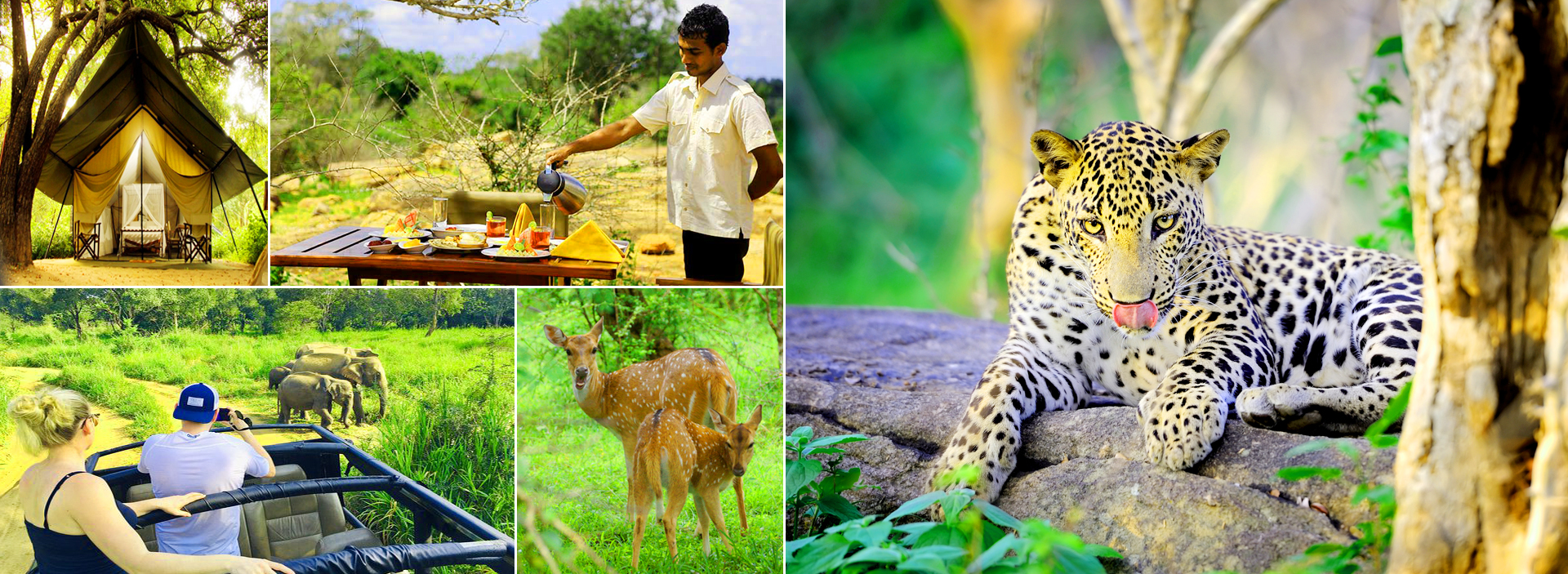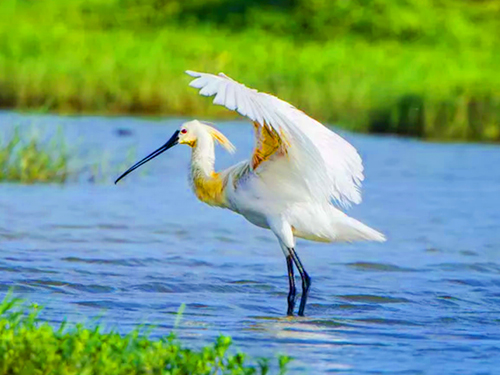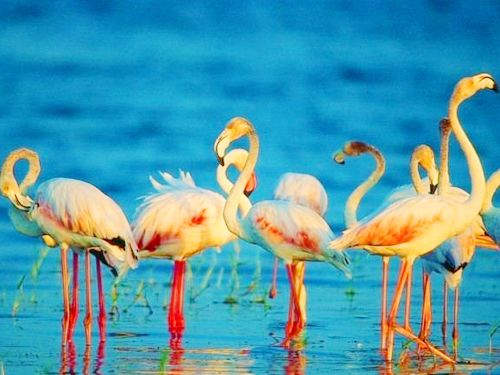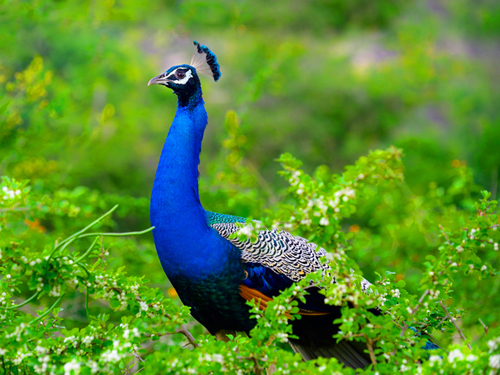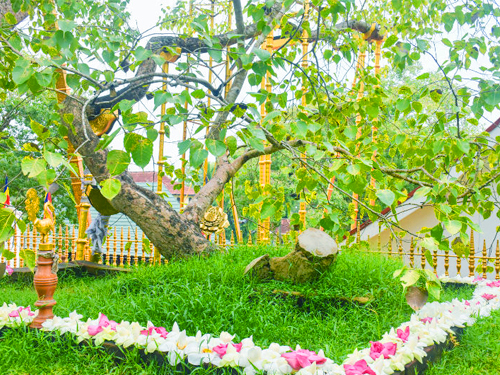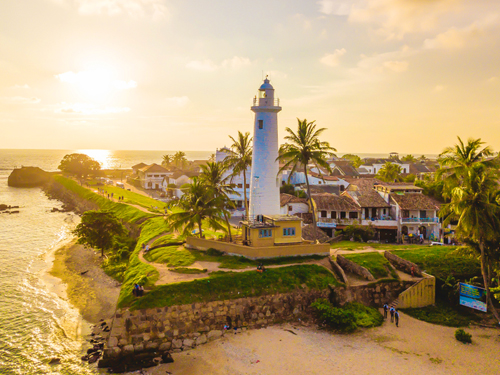Yala in Sri Lanka
Physical Features of Yala National Park
Most of the Yala area is composed of metamorphic rocks from the Precambrian age. It can be divided into two series: Vijayan series or Highland series. Reddish brown soils and low humic gray soils are the most prominent of six types. Yala is located in Sri Lanka's lowest peneplain, which stretches from Trincomalee towards Hambantota. Topographically, the area is flat and slightly undulating. It runs along the coast at 30m (98 ft), while the elevation in the interior is between 100-125m (328-410ft). The park is located in the semi-arid climate region. Rainfall is received mostly during the northeast monsoon. The average annual rainfall is between 500-775 millimetres (19.7-30.5 inches) and the temperature ranges from 26.4 degrees Celsius (79.5 degrees F) in January to 30 degrees Celsius (86 degF). Yala is more windy during the southwest monsoon than during the northeast monsoon, with winds speeds ranging from 23 km/h (14 mph), to 15 km/h (9.3mph).
After the northeast monsoon water is plentiful, but surface water becomes an important element during dry seasons. Surface water can be found in streams, tanks and waterholes as well as rock pools and lagoons. Low-lying areas are home to waterholes. Larger rock pools can hold water all year round and are therefore an important source for water for elephants. Natural waterholes provide ideal habitats for many waterbirds and water buffaloes. These reservoirs are concentrated in the Block I and Block II. There are several tanks there, including the MahaSeelawa and Buthawa tanks, Uraniya tanks, and Pilinnawa tanks. [2] Numerous streams and rivers flow southeastwardly from the central hills and highlands of Uva. KumbukkanOya to the east and Menik River to the west flow through the park and are an important water source for wild animals during dry seasons. The park's streams are usually dry in the drought season. These streams and rivers show a range of runoff fluctuations in between the wet and dry seasons. KumbukkanOya releases seven times more water in the rainy than the dry season. Numerous lagoons can be found along the park's coast. You can take several routes to Yala from Colombo. The shortest route is via Ratnapura or Tissamaharama, which takes you 270 kilometres.
Climate
The Yala National Park lies in Sri Lanka's lowest peneplain, which stretches from Trincomalee towards Hambantota. It is located 30 metres from the coast, and rises to 100 to 125 meters in the interior. It is located in the semi-arid climate region. The northeast monsoon is the predominant rainfall. It receives 500-775 mm of annual rainfall, while its average temperature is 26.4°C in January and 30°C in April.
History of Yala National Park
In 1560, a Spanish cartographer Cipriano Santiago noted that Yala was "abandoned for 300 years because of insalubrious circumstances." After travelling from Trincomalee and Hambantota, Chief Justice Sir Alexander Johnston wrote an extensive account of Yala in 1806. The Yala and Wilpattu Reserves were declared by the government under the Forest Ordinance on March 23, 1900. At first, the reserve covered 389 kilometres (150 mi) between the Menik River and the Kumbukkan Rivers. The reserve was not named Yala at that time. The establishment of the reserve was made possible by the Game Protection Society, now the Wildlife and Nature Protection Society. The reserve was designated a hunting area for only the residents of Yala and Palatupana. Henry Engelbrecht was elected the first park warden.
Yala was declared a national park on March 1, 1938 when D. S. Senanayake (minister of agriculture) passed the Flora and Fauna Protection Ordinance. Five blocks make up the park. The park was expanded to include four additional blocks. In the area of Yala, there are six national parks as well as three wildlife sanctuaries. The park is also home to Kumana National Park and Yala Strict Nature Reserve. There are three sanctuaries: Kataragama and Katagamuwa.
Bio Diversity
The most visited and second-largest national park in Sri Lanka is Yala National Park. It is made up of five blocks. Two of them are open to the public now, as well as adjoining parks. Each block is named differently, such as Ruhuna National Park (block 1) or Kumana National Park (block 2) for the adjacent area. It is located in the country's southeast, in Southern Province and Uva Province. It covers 979 km (378 mi) in area and is approximately 300 km (190 mi) away from Colombo. Yala was established as a wildlife sanctuary on May 1, 1900. It was also designated by Wilpattu in 1938. It is well-known for its wide range of wild animals. It is vital for the conservation and protection of Sri Lankan elephants, Sri Lankan Leopards and aquatic birds. In the area of Yala, there are six national parks as well as three wildlife sanctuaries. Lunugamvehera National Park is one of the most important. It is located in the semi-arid climate region. Rainfall is received mostly during the northeast monsoon. Yala is home to a wide variety of ecosystems, from freshwater and marine wetlands to moist monsoon forests. It is one the 70 Important Bird Areas in Sri Lanka. Yala is home to 215 bird species, including six endemic species from Sri Lanka. The park has the highest number of leopards in the world, with 44 mammals being recorded. Many ancient civilisations have been found in the Yala area. The park contains two important pilgrim sites, Sithulpahuwa (or MagulVihara), 250 people were killed in the Yala National Park's vicinity after the 2004 Indian Ocean tsunami. Since 2009, the park's security has improved and the number of visitors to the park has increased.
Yala National Park: Animals
The most visited and second-largest national park in Sri Lanka is Yala National Park. It is made up of five blocks. Two of them are open to the public now, as well as adjoining parks. Each block is named differently, such as Ruhuna National Park (block 1) or Kumana National Park (block 2) for the adjacent area. It is located in the country's southeast, in Southern Province and Uva Province. It covers 979 km (378 mi) in area and is approximately 300 km (190 mi) away from Colombo. Yala was established as a wildlife sanctuary on May 1, 1900. It was also designated by Wilpattu in 1938. It is well-known for its wide range of wild animals. It is vital for the conservation and protection of Sri Lankan elephants, Sri Lankan Leopards, and aquatic birds. In the area of Yala, there are six national parks as well as three wildlife sanctuaries. Lunugamvehera National Park is one of the most important. It is located in the semi-arid climate region. Rainfall is received mostly during the northeast monsoon. Yala is home to a wide variety of ecosystems, from freshwater and marine wetlands to moist monsoon forests.
It is one the 70 Important Bird Areas in Sri Lanka. Yala is home to 215 bird species, including six endemic species from Sri Lanka. 44 mammals have been identified from the park, making it one of the most leopard-rich areas in the world. Many ancient civilisations have been found in the Yala area. The park contains two important pilgrim sites, Sithulpahuwa (or MagulVihara), 250 people were killed in the Yala National Park's vicinity after the 2004 Indian Ocean tsunami. Since 2009, the park's security has improved and the number of visitors to the park has increased.
Leopards in Yala National Park
Yala is known for its leopard-loving residents. It is also considered one of the best spots in the world to see leopards. Yala is believed to have the highest concentration of leopards anywhere in the world. We make it a point to show the diversity of Yala's wildlife on safaris with Leopard Trails. Over 100 species of birds can be identified and identified during a stay of two nights. Yala's mugger crocodile population is another highlight of the park.
Yala Elephants
The Sri Lankan elephant (Elephasmaximusmaximus), is one of three subspecies of Asian elephants that are recognized. It is native to Sri Lanka. IUCN has listed Elephasmaximus as endangered since 1986 because the species' population has decreased by at least 50% in the past three generations. This is a period of 60 to 75 years. Habitat loss, degradation, and fragmentation are major threats to the species. Elephas Maximus Maximus, the subspecies type of the Asian elephant was first described in 1758 by Carl Linnaeus.
The Sri Lankan elephant population has been largely reduced to the northern, eastern and southeast regions of Sri Lanka. Although elephants can be found in Udawalawe National Park and Yala National Park, Lunugamvehera National Park and Wilpattu National Park, Wilpattu National Park, Minneriya National Park and Lunugamvehera National Park respectively, they also exist outside of protected areas. Sri Lanka is home to the largest concentration of elephants in Asia, according to estimates. Conversion of elephant habitats to permanent cultivation and settlements is increasing human-elephant conflict.
There are very few chances that you will see a Sri Lankan Sloth Bear at Yala National Park. You should not take a 4x4 Safari. Ask your driver or guide to provide a sighting report. National Parks are not zoos. It eats roots, berries and nuts.
Sri Lankan Sloth Bears in Yala National Park
It is an omnivore, meaning it can eat anything. To get to the insects beneath, they will flip over rocks and pull apart old logs. Over time, they have developed a lower lip that is used by bears to suck up insects. This makes a loud hovering sound.
This is Baloo, the Jungle Book bear. Both have long, digging claws and light-coloured noses. Sloth bears are found mainly in lowland forest, but can be seen occasionally walking along the rocky outcrops in the park.
To survive, the Sloth Bear depends on the richness of the lowland jungle forest. Its near extinction was due to its destruction as farm land. It is only found in protected areas like Yala National Park. Local farmers have hunted some bears for their food. Sloth bears are very wary of humans, and will attack you if they come within their territory.
Europeans mistook the large claws of the Sloth bear for the same genetic line as the South American Sloths when they first saw them. The mistake was quickly corrected, but the name stuck. Sloth Bear claws can reach up to 4 inches in length.
Female Sloth Bears are expected to search for a cave or den to give birth. This can happen at any time during the year in Sri Lanka. At 4 weeks old, the cubs are able to open their eyes and mature faster than other bears. As they walk along the forest floor and rocks, cubs can be seen holding on to their mother's backs.
In their third year, the cubs are separated from their mother and sexually mature by their third birthday. A mother will re-inject food that she ate during the day to wean her cubs from her milk and give it to her cubs. Because it hardens in sunlight, this is known as "bears bread". It is rich in sweet ingredients like honeycomb, jack fruit and apples.
Yala National Park Birds
Yala is home to 215 species of birds, seven of which are endemic to Sri Lanka. It is one of 70 Important Bird Areas in Sri Lanka. These include the Sri Lankan grey hornbill and Sri Lankan junglefowl. There are 90 water birds that live in Yala's wetlands. Half of these birds are migrants. Waterfowl (lesser whistling Duck, garganey), Cormorants (little cormorant and Indian cormorant), large birds (grey herons, black-headed Indian ibis), Eurasian spoonbills, Asian openbills, painted stork), medium-sized Waders Tringa, Charadrius, and small waders Charadrius, spp. These are the most common waterbirds. The park is home to many rare birds, including the black-necked and lesser adjutant. Also, the resident spot-billed and migrant greatwhite pelicans were both recorded. The Yala lagoons are also home to lesser flamingos, pelicans and rare species like the Oriental darter, night herons and egrets. During the northeast monsoon, thousands of waterfowls flock to Yala's lagoons. These include the northern pintail, white wingedtern, Eurasian curlew, Eurasian whipbrel, godwits and ruddy turningstone. They mixed with the residing lesser whistling bird, yellow-wattled lapwing, red-wattled lapwing, and great rock-curlew. Other bird species include rock pigeons, Indian peafowls, barred buttonquail and black stork. The park's raptors include the white-bellied sea bird and the crested serpent eagle. The forest birds include the orange-breasted pigeon, hornbills and white-bellied sea eagle.
Water Buffalo in Yala National Park
The landscape of Yala National Park is notable for its vast expanses of flooded grassland that changes with the Monsoons. This environment is a favorite for the Sri Lankan Water Buffalo. The tropical heat is cooling the water.
It is a relief from the hundreds upon hundreds of blood sucking insects. They also rely on these lagoons for their main food source. The lush grass and leaves. They can swim in the water with Leopards, but must be careful of large Crocodiles. At small waterholes, you may also see family groups of Sri Lankan Wasser Buffalo. Although they may look like large cows, they are not allowed to get too close. They can reach 6 feet high at the shoulders. Leopards can be defeated by adult Water Buffalos thanks to their size and horns. Unarmed humans are nothing. You will be trompled and attacked by its horns if you fall.
Yala National Park's water buffaloes are wild. Domestication has been done in Sri Lanka and India to raise May buffalo. They can be used to transport loads, pull wagons, ploughs, and provide meat and milk. Their dung can be used to fertilize the soil and dried buffalo poo used as fuel. Because they can live in swampy conditions, they are more efficient than common cattle in working in paddy rice fields. They are able to navigate through muddy fields and Sri Lankan marshes with their large, splayed hooves.
Yala National Park Land Monitor
Yala National Park is home to a number of Sri Lankan Land Monitor Lizards. Many were seen on the ground, hunting for their dinner. They enjoy the sun up in trees for safety. They blend in with the natural shapes of tree branches so you need good eyesight to identify them. Two types of monitor Lizards are found in Sri Lanka: the common Land Monitor Lizard, (VaranusBengalensis), and the Water Monitor Lizard, (Varanussalvatator). The common land Monitor can be found in Sri Lanka's hot lowland countries. They are not found in areas of Sri Lanka above 500m above the sea level because it is too cold. They are able to survive in many habitats, from jungle rain forests to desert scrub.
Local farmers encourage the lizards to roam around their fields while they eat vermin. The lizards eat small invertebrates like fruit, insects, scorpions and spiders. They can reach just over 5ft and weigh in excess of 10kg. They are one of the largest lizards on the planet.
They keep warm at night by crawling in burrows, holes and on protective ledges to keep warm. To keep their bodies warm, they spend their mornings sunbathing. They are not usually active in the morning. They are active hunters in the midday sun. They can climb vertically up trees thanks to their long nails at the ends of their fingers.
Females can lay up to 30 eggs. She then places them in a depression she dug and covers them with soil. As a place to rest their eggs, some have used holes in fallen trees and rotting stumps. The daily temperature affects the time it takes for eggs to incubate. You can spot its tongue. It has a purple color and is forked. The tips have odour detector sensors that help them detect the next meal.
These particles are brought back to the tongue by the Jacobson organ, which can sense the strength of each forked tongue tip. The Jacobson organ then determines which direction to go. The Land Monitor Lizard in Sri Lanka is listed as "commercially endangered" because they are used to harvest meat for local consumption.
Flora in Yala National Park
Yala National Park is home to a range of ecosystems. These include dry monsoon forest, semi deciduous forest, semi deciduous forests and thorn forests. It also has grasslands, marshes and marine wetlands. Block I and rangelands (pelessa grasslands), which include extensive grasslands, make up the majority of forest area. Forests are located around the Menik River, while rangelands can be found to the seaside. The Block I also includes tanks, water holes and lagoons as well as mangroves, mangroves, and chena lands. Mangrove vegetation in Buthuwa lagoon is mostly Rhizophoramurinata, while Avicennia species are predominant. Aegiceras and Aegiceras species. are less abundant. Block II vegetation is similar to Block I. Yalawela was once a fertile paddy fields. Block II's mangroves are located around the Menik River estuary, and cover 100 hectares (0.39 sq mi). Common mangrove plants include Sonneratiacaseolaris and Rhizophoramucronata. This block also contains the lagoons of Mahapothana and Pilinnawa. Acanthus ilicifolius and Excoecariagallocha are the other mangrove species. Crinum zeylanicum can be found in the bare sand.
Forests are more common in Blocks III, IV and V. The forest canopy is dominated by Drypetessepiaria, ManilkaraHexandra and Manilkarahexandra species. Important for animals to graze, the Pitiya grasslands provide a natural habitat. Cynodonbarberi dominates the pitiya grasslands, while Zoysiamarella is dominant at the beach. Manilkarasepiaria is one of the rarest floral species. A wild rice species is found in Block II's seasonally flood areas. Glennieaunijuga, an endemic species of plant, is found in the park's wetlands. Some medicinal plants include Munroniapumila and Salaciareticulata.
The best time to visit Yala National Park is for the Game Drive Safari
Yala National Park is open from 06:00 AM to 06:00 PM each evening. Authorities are very strict about timings and do not allow for any prior delay. Consistent traffic can be seen as hundreds of tourists and travelers travel in jeeps along the roads to Yale National Park. It is better to have a spare hour before you leave for the safari.
Yala National Park is located in the southeastern coast region. It is usually dry throughout the year, except during monsoons. Tourist preferences for visiting Sri Lanka during monsoon change as Sri Lanka has two distinct monsoon seasons. The Southeast region experiences rain from October through January. Therefore, February to July is a better time to visit. Because of the heat, water levels are low at this time. This allows for more aquatic animals to be seen.
Things to Do in Yala National Park
Safari rides are the most important thing that visitors to Yala National Park should not miss. A safari ride is an attraction for anyone visiting Yala National Park and looking to see wildlife at its best. Safari tours can be conducted by licensed companies. You can book safari tours within Yala National Park. You can also pre-book your safari tour. There are two types of Safari tours: half-day tours and full-day tours. Individuals can pick their own tour based on time, budget and other constraints.
Yale National Park is home to around 215 bird species. Both migrant and endemic birds are found in Yale National Park. Visitors will be amazed at the variety of colours and birds, even if they are not interested in birdwatching. You will find birds such as the Orange Breasted Green Pigeon and Hornbills. It will be a wonderful experience to see so many birds together.
Nature lovers can also experience the joy of nature by staying in Yala National Park's bungalow. You can also reserve the bungalow in advance. Although the bungalow isn’t luxurious, it offers a more rural and rustic experience. It's no surprise to hear the gentle yawning of leopards or the slow, trumpeting footsteps of elephants. It will be a wonderful and memorable experience to wake up in the morning among nature and wildlife.
On a visit to Yala National Park, one can see the 2200-year-old Buddhist monastery. Sithulpawwa, an ancient rock temple known as Sithulpawwa, is believed to have been the home of 12,000 monks. Here you can find images of Buddha and Bodhisattva. This monastery is well worth a visit if you have an affinity for archaeology and history.
Camping sites are available within the park. A family of 10 with two children under 6 years old is allowed to use a single campsite with no more than three days of living. Camping takes on a new meaning in Yala National Park. Under the stars, you can see wildlife at its finest and the natural world surrounding you. Camping is governed by strict rules. These include no alcohol consumption, smoking, loitering, littering food and keeping campsites and tents clean.
For recreational purposes, the coastline facing Yala National Park is closed to the public. You can visit designated areas with safety precautions. You can also take a short walk along the beach. You can also visit the Tsunami site, which claimed many lives.
You can reach Yala National Park by air, train or car. However, there is no direct transport to Yala National Park. Kataragama is the nearest town to Yala National Park. Tourists can also travel to Tissamaharama Town. The journey can be continued by Yala National Park jeeps. You can first travel to Bandaranaike International Airport, Colombo. You can then fly to MattalaRajapaksa International Airport in Hambantota and take a jeep to Yala National Park.
You can also take the train from Colombo, Haputale, and then get a car. Buses from Colombo can also be taken, but they might take up to 9 hours.
The whole area under Yala National Park can be divided into five blocks. The blocks are not accessible to the general public. There is also no single gate. There are five blocks located in five different areas. While Blocks I and II have gates at the Katagamuwa and Palatupana, Block II must be entered through Block I. Galge has gates for Block III and V, while Block IV is closed to the public. Tourists should choose their preferred gate for entry to the park in advance.
Although a park guide is not necessary, most drivers speak very little English. It is helpful to have a guide on hand to help you spot animals and determine the best route. They can also explain the park's life cycle. You will gain a better understanding about the behavior of the animal and can ask questions during the safari.
Yala, with its diverse flora & fauna, is an unforgettable experience. It is one of Sri Lanka's must-see places. It is worth visiting the park at any time of year. However, it is best to plan your visit in peak season (December-April). You should remember that leopard sightings are not guaranteed, even if you're in peak leopard season .However, you will be able to spot large numbers of elephants and their babies in the park.
Prices for tickets vary for children and adults from other countries.
- Tickets for adults: $ 15
- Tickets for children: $ 8
These are the base prices for entry to the park. Tour plans have separate prices.In addition to the ticket prices, a service charge will be applied for jeep use. VAT must also be paid. With more people using the jeep, the jeep service fee will decrease.

 Safe Travels
Safe Travels Français
Français Deutsch
Deutsch עִברִית
עִברִית Italiano
Italiano Nederlands
Nederlands Polski
Polski Pусский
Pусский Español
Español